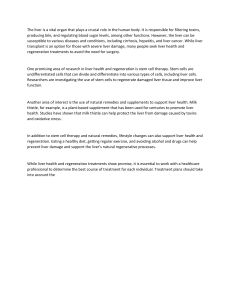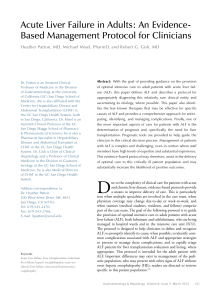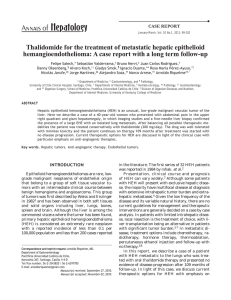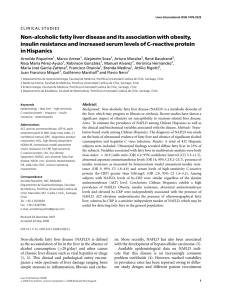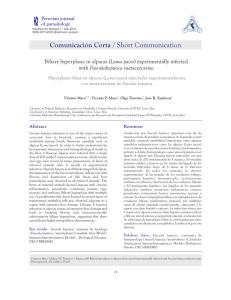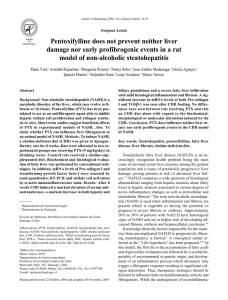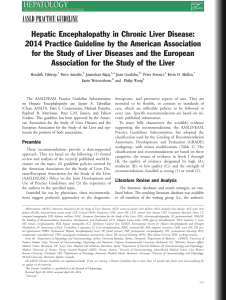Ode to the Liver
Anuncio
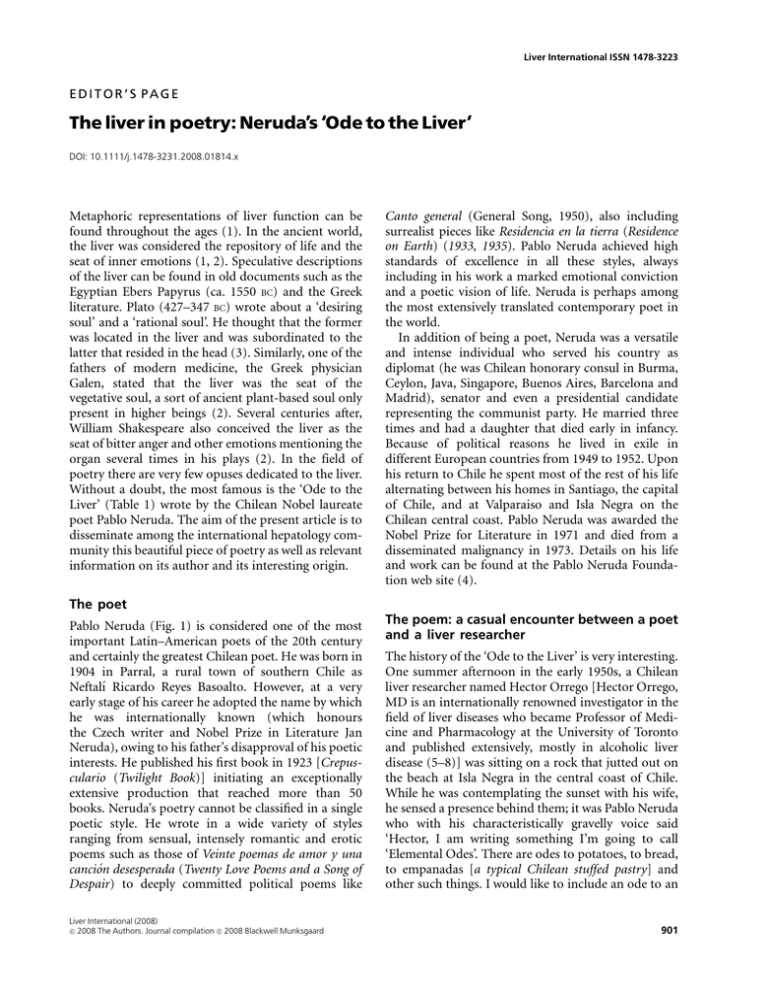
Liver International ISSN 1478-3223 EDITOR’S PAGE The liver in poetry: Neruda’s ‘Ode to the Liver’ DOI: 10.1111/j.1478-3231.2008.01814.x Metaphoric representations of liver function can be found throughout the ages (1). In the ancient world, the liver was considered the repository of life and the seat of inner emotions (1, 2). Speculative descriptions of the liver can be found in old documents such as the Egyptian Ebers Papyrus (ca. 1550 BC) and the Greek literature. Plato (427–347 BC) wrote about a ‘desiring soul’ and a ‘rational soul’. He thought that the former was located in the liver and was subordinated to the latter that resided in the head (3). Similarly, one of the fathers of modern medicine, the Greek physician Galen, stated that the liver was the seat of the vegetative soul, a sort of ancient plant-based soul only present in higher beings (2). Several centuries after, William Shakespeare also conceived the liver as the seat of bitter anger and other emotions mentioning the organ several times in his plays (2). In the field of poetry there are very few opuses dedicated to the liver. Without a doubt, the most famous is the ‘Ode to the Liver’ (Table 1) wrote by the Chilean Nobel laureate poet Pablo Neruda. The aim of the present article is to disseminate among the international hepatology community this beautiful piece of poetry as well as relevant information on its author and its interesting origin. Canto general (General Song, 1950), also including surrealist pieces like Residencia en la tierra (Residence on Earth) (1933, 1935). Pablo Neruda achieved high standards of excellence in all these styles, always including in his work a marked emotional conviction and a poetic vision of life. Neruda is perhaps among the most extensively translated contemporary poet in the world. In addition of being a poet, Neruda was a versatile and intense individual who served his country as diplomat (he was Chilean honorary consul in Burma, Ceylon, Java, Singapore, Buenos Aires, Barcelona and Madrid), senator and even a presidential candidate representing the communist party. He married three times and had a daughter that died early in infancy. Because of political reasons he lived in exile in different European countries from 1949 to 1952. Upon his return to Chile he spent most of the rest of his life alternating between his homes in Santiago, the capital of Chile, and at Valparaiso and Isla Negra on the Chilean central coast. Pablo Neruda was awarded the Nobel Prize for Literature in 1971 and died from a disseminated malignancy in 1973. Details on his life and work can be found at the Pablo Neruda Foundation web site (4). The poet Pablo Neruda (Fig. 1) is considered one of the most important Latin–American poets of the 20th century and certainly the greatest Chilean poet. He was born in 1904 in Parral, a rural town of southern Chile as Neftalı́ Ricardo Reyes Basoalto. However, at a very early stage of his career he adopted the name by which he was internationally known (which honours the Czech writer and Nobel Prize in Literature Jan Neruda), owing to his father’s disapproval of his poetic interests. He published his first book in 1923 [Crepusculario (Twilight Book)] initiating an exceptionally extensive production that reached more than 50 books. Neruda’s poetry cannot be classified in a single poetic style. He wrote in a wide variety of styles ranging from sensual, intensely romantic and erotic poems such as those of Veinte poemas de amor y una canción desesperada (Twenty Love Poems and a Song of Despair) to deeply committed political poems like Liver International (2008) c 2008 Blackwell Munksgaard 2008 The Authors. Journal compilation c The poem: a casual encounter between a poet and a liver researcher The history of the ‘Ode to the Liver’ is very interesting. One summer afternoon in the early 1950s, a Chilean liver researcher named Hector Orrego [Hector Orrego, MD is an internationally renowned investigator in the field of liver diseases who became Professor of Medicine and Pharmacology at the University of Toronto and published extensively, mostly in alcoholic liver disease (5–8)] was sitting on a rock that jutted out on the beach at Isla Negra in the central coast of Chile. While he was contemplating the sunset with his wife, he sensed a presence behind them; it was Pablo Neruda who with his characteristically gravelly voice said ‘Hector, I am writing something I’m going to call ‘Elemental Odes’. There are odes to potatoes, to bread, to empanadas [a typical Chilean stuffed pastry] and other such things. I would like to include an ode to an 901 902 Modest, organized friend, underground worker, let me give you the wing of my song, the thrust of the air, the soaring of my ode: it is born of your invisible machinery, it flies from your tireless confined mill, delicate powerful entrail, ever alive and dark. While the heart resounds and attracts the music of the mandolin, there, inside, you filter and apportion, you separate and divide, you multiply and lubricate, you raise and gather the threads and the grams of life, the final distillate, the intimate essences. Table 1. ‘Ode to the Liver’ Submerged viscus, measurer of the blood, you live full of hands and full of eyes, measuring and transferring in your hidden alchemical chamber. Yellow is the matrix of your red hydraulic flow, diver of the most perilous depths of man, there forever hidden, everlasting, in the factory, noiseless. And every feeling or impulse grew in your machinery, received some drop of your tireless elaboration, to love you added fire or melancholy, let one tiny cell be in error or one fiber be worn in your labor and the pilot flies into the wrong sky, the tenor collapses in a wheeze, the astronomer loses a planet. Up above, how the bewitching eyes of the rose and the lips of the matinal carnation sparkle! How the maiden in the river laughs! And down below, the filter and the balance, the delicate chemistry of the liver, the storehouse of the subtle changes: no one sees or celebrates it, but, when it ages or its mortar wastes away, the eyes of the rose are gone, the teeth of the carnation wilted and the maiden silent in the river. Austere portion or the whole of myself, grandfather of the heart, generator of energy: I sing to you and I fear you as though you were judge, meter, implacable indicator, and if I can not surrender myself in shackles to austerity, if the surfeit of delicacies, or the hereditary wine of my country dared to disturb my health or the equilibrium of my poetry, from you, dark monarch, giver of syrups and of poisons, regulator of salts, from you I hope for justice: I love life: Do not betray me! Work on! Do not arrest my song. Editor’s page Arrese c Liver International (2008) c 2008 Blackwell Munksgaard 2008 The Authors. Journal compilation c Liver International (2008) c 2008 Blackwell Munksgaard 2008 The Authors. Journal compilation Vı́scera submarina, medidor de la sangre, vives lleno de manos y de ojos, midiendo y trasvasando en tu escondida cámara de alquimista. Amarillo es tu sistema de hidrografı́a roja, buzo de la más peligrosa profundidad del hombre, allı́ escondido siempre, sempiterno, en la usina, silencioso. Y todo sentimiento o estı́mulo creció en tu maquinaria, recibió alguna gota de tu elaboración infatigable, al amor agregaste fuego o melancolı́a, una pequeña célula equivocada o una fibra gastada en tu trabajo y el aviador se equivoca de cielo, el tenor se derrumba en un silbido, al astrónomo se le pierde un planeta. Cómo brillan arriba los hechiceros ojos de la rosa, los labios del clavel matutino! Cómo rı́e en el rı́o la doncella! Y abajo el filtro y la balanza, la delicada quı́mica del hı́gado, la bodega de los cambios sutiles: nadie lo ve o lo canta, pero, cuando envejece o desgasta su mortero, los ojos de la rosa se acabaron, el clavel marchitó su dentadura y la doncella no cantó en el rı́o. Austera parte o todo de mi mismo, abuelo del corazón, molino de energı́a: te canto y temo como si fueras juez, metro, fiel implacable, y si no puedo entregarme amarrado a la pureza, si el excesivo manjar o el vino hereditario de mi patria pretendieron perturbar mi salud o el equilibrio de mi poesı́a, de ti, monarca oscuro, distribuidor de mieles y venenos, regulador de sales, de ti espero justicia: Amo la vida: Cúmpleme! Trabaja! No detengas mi canto. c 1975. Reprinted with permission of the Centre for Addiction and Mental Health, Toronto. wIncluded in Nuevas Odas Elementales (New Elemental Odes), Losada Publishers, Buenos Aires, 1956; Reprinted with permission. Translated by Oriana Josseau Kalant, as published in Alcohol Liver Pathology (J.M. Khana, Y. Israel, and H. Kalant, editors) Modesto, organizado amigo, trabajador profundo, déjame darte el ala de mi canto, el golpe de aire, el salto de mi oda: ella nace de tu invisible máquina, ella vuela desde tu infatigable y encerrado molino, entraña delicada y poderosa, siempre viva y oscura. Mientras el corazón suena y atrae la partitura de la mandolina, allı́ adentro tú filtras y repartes, separas y divides, multiplicas y engrasas, subes y recoges los hilos y los gramos de la vida, los últimos licores, las ı́ntimas esencias. ‘Oda al Higado’w Arrese Editor’s page 903 Editor’s page Arrese their arrogance, would be prosaic. With an ode to the liver ‘you would be drawing back a veil, mending an injustice’ Orrego said. Neruda laughed and said ‘Tell me more’, and Orrego did, completing a real ‘crash course’ of liver physiology that excited the poet. The next day Neruda showed to Orrego the ‘Ode to the Liver’ (Table 1) written in green ink in his typical oversized handwriting. The final version was published in 1956 in a book entitled Nuevas odas elementales (New Elemental Odes) (9) which was the second of three books containing odes inspired by a wide variety of things (10, 11). The ode’s English translation Fig. 1. Pablo Neruda (1904–1973) organ of the body. The heart always sounds a little snobbish, and I have already done enough on sex in my poetry. The other day Alfonso Asenjo (famous Chilean neurosurgeon) was here and he suggested I use the brain. What do you think?’. Dr Orrego just said ‘the liver would be better’. Neruda was surprised, but then sat down by Orrego’s side and said ‘tell me about the liver’. Dr Orrego explained to the poet about liver functions and how the organ resembles a laboratory that modifies everything and maintains the chemistry of the body, of how the organ detoxifies, metabolizes and forms every class of substance indispensable for the other organs of the body to function, including the brain. ‘Given that the brain depends on the liver in order to function, you should take care of it because if your liver fails you might not go on writing more poems’, the hepatologist said to the poet. Moreover, he mentioned that there would be some justice in elevating the liver to the level of poetry. He also said that the liver is a modest organ, so little mentioned, so hidden despite having such a fundamental role. Thus, to celebrate the brain, which has given human beings 904 Even though Neruda’s poetry has been extensively translated, the book containing the ode to the liver was not. Only selected poems from this book have been included in several anthologies (12, 13). This of course limited the dissemination of the hepatological piece of literature. However, in 1973 and by mere serendipity, in Canada a group of people gathered that made possible the English translation and publication of the liver ode. An International Symposium on Alcohol and Drug Research was held in Toronto, 15–18 1973 (co-sponsored by the Canadian Department of National Health and Welfare and the Alcoholism and Drug Addiction Research Foundation) and a book containing the papers presented at the Liver Pathology Section entitled ‘Alcoholic liver pathology’ (14) was compiled. Among the book’s editors were the renowned Canadian pharmacologist Harold Kalant, PhD and his young Chilean research fellow Yedi Israel, PhD. It was Dr Israel’s idea to include a literary piece referring to the liver in the final version of the book. Fortunately, by that time Hector Orrego was working at the University of Toronto and he proposed to include the ode he helped inspire almost 20 years before. Then a translation was needed. Fortunately, Dr Kalant was married to a very talented Chilean woman, Oriana Josseau Kalant, who was herself a brilliant researcher in the field of addiction (15). Thus, Dr Josseau Kalant translated the ode doing an extraordinary job (Table 1). The ode was finally included in the book and later reproduced in a journal (16) and in a book containing the proceedings of a Falk Symposium held in Chile in 1995 (17). Another English translation was written later by Will Hochman, a poet and teacher at Southern Connecticut State University with the help of a Mexican writer named Heberto Morales. This version is available in Hochman’s website (18). c Liver International (2008) c 2008 Blackwell Munksgaard 2008 The Authors. Journal compilation Arrese Editor’s page Concluding remarks The ‘Ode to the Liver’ represents an interesting example of the relationship between poetry and medicine (19), being a perfect blend of artistic inspiration and scientific thought. However, in spite of having been published in some medical literature, knowledge on the Ode’s existence is not ample, as judged by informal surveys made by the author of this article. I wished to mend this injustice by making the ode available to the hepatology community and recounting its fortuitous story. Moreover, this article is offered as a new and widely available bibliographic source for those interested in this beautiful poem. Marco Arrese Pontificia Universidad Católica de Chile, Santiago, Chile Dedication: This article is dedicated to Hector Orrego, the inspiring mind behind the Ode and to the memory of Oriana Josseau Kalant who translated it so marvelously. Acknowledgements The author acknowledges the indispensable help of Hector Orrego, Yedi Israel and Harold Kalant, who provided firsthand information on how the ‘Ode to the Liver’ was generated and translated. The help of George Montgomery in the manuscript preparation was also invaluable. References 1. Kuntz E, Kuntz H. History of hepatology. In: Hepatology, Principles and Practice. Heidelberg: Springer Medizin Verlag, 2006; 2–12. Liver International (2008) c 2008 Blackwell Munksgaard 2008 The Authors. Journal compilation c 2. Reuben A. The body has a liver. Hepatology 2004; 39: 1179–81. 3. Cahill KM. Platonic concepts of hepatology. Arch Intern Med 1963; 111: 819–22. 4. Pablo Neruda Foundation [cited 2008 May, 26]; Available from: http://www.fundacionneruda.org/ing/home_ingles.htm 5. Orrego H, Blake JE, Blendis LM, Compton KV, Israel Y. Long-term treatment of alcoholic liver disease with propylthiouracil. N Engl J Med 1987; 317: 1421–7. 6. Orrego H, Blendis LM, Israel Y. Hepatocyte enlargement and portal hypertension. Hepatology 1990; 12: 1454. 7. Orrego H, Israel Y. Biochemical, morphological and clinical correlates of alcoholic liver disease. Adv Exp Med Biol 1980; 132: 497–508. 8. Orrego H, Israel Y, Blendis LM. Alcoholic liver disease: information in search of knowledge? Hepatology 1981; 1: 267–83. 9. Neruda P. Nuevas Odas Elementales. Buenos Aires: Losada, SA, 1956. 10. Neruda P. Tercer libro de las odas. Buenos Aires: Losada, 1957. 11. Neruda P. Odas Elementales. Buenos Aires: Losada, 1954. 12. Neruda P, ed. The Poetry of Pablo Neruda. New York: Farrar, Straus and Giroux, 2005. 13. Neruda P. Neruda’s Garden: An Anthology of Odes. Tempe, AZ: Latin American Literary Review Press, 1995. 14. Khanna JM, Israel Y, Kalant H, Lambert S, eds. Alcoholic Liver Pathology. Toronto: Alcoholism and Drug Addiction Research Foundation of Ontario, 1975. 15. Jaffe JH. Oriana Josseau Kalant, 1920–2001: a remarkable scientist, a remarkable woman. Addiction 2002; 97: 1356–7. 16. Mann RE, Smart RG, Govoni R. The epidemiology of alcoholic liver disease. Alcohol Res Health 2003; 27: 209–19. 17. Reyes HB, Leuschner U, Arias IM. Pregnancy, Sex Hormones and the Liver. Dordrecht: Kluwer Academic Publishers, 1996. 18. Morales H, Hochman W. Ode to the Liver (translation). [cited 2008 May, 28]; Available from: http://www.southernct. edu/hochman/Ode2liver 19. Bromberg R. Poetry and medicine. Medscape J Med 2008; 10: 63. 905
